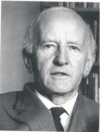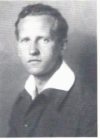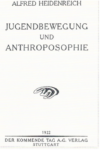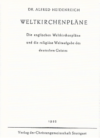Alfred Heidenreich
Die Gruender der Christengemeinschaft: Ein Schicksalsnetz
By Rudolf F. Gaedeke published by Urach Haus
Translated by Rev. Cindy Hindes
Images sourced therefrom

Alfred Heidenreich, 1967
Alfred Heidenreich
January 17, 1898, Regensburg – March 11, 1969, Johannesburg
Alfred Heidenreich was the youngest Christian Community Lenker since its foundation, proposed by Rudolf Steiner, and recognized by the priesthood. On Rudolf Steiner’s advice, his priestly mission took him to England, later to America, South America, and finally to South Africa, where he died in Johannesburg during a journey. Of all the founders, he was, without doubt, the man with the widest horizon of experience, both geographically and spiritually. He had acquired a comprehensive knowledge of German-speaking and English-speaking intellectual history. He was a man of the world in the best sense, as Rudolf Steiner wished many representatives of anthroposophy to be. He had a perfect command of the English language and was equally successful as the editor of the English journal The Christian Community and as a speaker. A knowledgeable connoisseur of anthroposophy and an alert and sharp judge of contemporary events, he had appropriated the ideas and techniques of Rudolf Steiner’s social suggestions – as few in the circle of priests had done – and knew how to apply them masterfully. As a Lenker, and from 1938 on as an Oberlenker, he actively impulsed and shaped the development of the Christian Community for decades until his death.

Heidenreich, 1920
Alfred Heidenreich was born in Regensburg on the Danube on January 17, 1898, the fifth of six children. His father, Georg Jakob Heidenreich, was already 52 years old at his birth, a tax official whose ancestors had been expelled from the Austrian Waldviertel (Heidenreichstein) as Protestants. His four siblings were older than him by a wide margin. His mother Henriette was a née Dannheimer.
The boy attended elementary school from 1904 and, in September 1908, at the age of ten, passed the entrance examination to the Royal Old (humanistic) Gymnasium, which had once been founded by Albertus Magnus. The old imperial city of Regensburg stimulated many historical interests in the very tender boy. For years he went daily past the famous Scots Church of St. James, a direct reminder of the (second) Irish mission to the continent. The old monastery of St. Emmeran, the Romanesque churches, the Gothic cathedral with the jewel of the All Saints Chapel, the stone bridge over the Danube that has been preserved from the Hohenstaufen period, the old patrician towers, and the remains of the Roman city – these are all living witnesses of two thousand years of history that deeply impressed the boy.
And soon, his father especially liked to take the son Alfred with him on his lonely hikes in the city’s beautiful surroundings. Since then, Alfred Heidenreich had been a companionable or also solitary hiker and mountaineer throughout his life.
Schooling consisted primarily of language instruction: first Latin, then Greek, French, and finally Italian as an optional subject. Apart from mathematics and mathematical physics, there were no scientific subjects – a classical education for the ‘ivory tower elite,’ in which the educated bourgeoisie largely lived, without real contact with the emerging problems of the time. Alfred was at the head of the class. When he went off to war in the fall of 1916 with an early school-leaving certificate – Abitur – he had already been an active Wandervogel guide for years on behalf of the elders who had become soldiers before him. Apart from the encounter with two teachers, there was no humanly significant experience at school. It was quite different in the community life of the youth movement.
With his Lutheran Confirmation, his interest in religion and church had ceased. Alfred was attached to his family, parents, and siblings but always felt strange, different. The “Dignity and Security of Officialdom,” which his three brothers also entered, repelled him. But he was also – in an inner way – alien to himself, a homeless soul. Alfred Heidenreich described all this in detail, first in the magazine “The Christian Community” and later in his book about the founding of the Christian Community (Growing Point, 1965; German: Aufbruch, Stuttgart 2000).
On October 18, 1913, on the Hohe Meißner, near Kassel, the now famous meeting of many free youth alliances had taken place, which summarized their thoughts and their will in the Meißner Formula: “Young people want to shape their lives out of their own determination, before their own responsibility, with inner truthfulness” (see Fritz Blättner, Geschichte der Pädagogik).
Alfred Heidenreich, who joined the leadership of the youth movement at the beginning of the war, later felt this formula to be an essence of what Rudolf Steiner had worked out in his Philosophy of Freedom, just not philosophically formulated but clearly felt.
At eighteen and a half, he had to leave the familiar and beloved world of his birthplace and the Wandervogel life. The brutal events of the war dragged the young man into the material battles of Ypres and later into English captivity on the north coast of France. He had to endure extremely severe humiliations at the hands of the English, which affected him deeply.
He was released in the fall of 1919 after an English guard showed him the white chalk cliffs of Dover on a clear day across the channel, “There, England!” which Alfred Heidenreich always remembered as a first hint of destiny.
At the end of October, he began studying national economics in Munich. Of course, the days off at the beginning of November were used for a trip to the Wendelstein. The group had to divide, and some of them followed.
On November 2, 1919, Marta Heimeran and Alfred Heidenreich met in the small train station in Bayrischzell, and both later described that this first meeting had been a deep recognition for them. A lifelong struggle for common ground began.
In the summer semester of 1920, they both stayed in Rostock, but there was more hiking than studying, so they separated for the winter semester of 1920/21. Marta Heimeran went to Tübingen, Alfred Heidenreich back to Munich. In March 1921, the ‘Open Anthroposophical University Course’ took place in Stuttgart. Rudolf Steiner gave eight lectures on Observation of Nature, Mathematics, Scientific Experimentation, and the Results of Knowledge from the Point of View of Anthroposophy (today in GA 324). Marta Heimeran sent a program of the meeting to Alfred Heidenreich, who had no plans to travel there, with the handwritten remark, “So you know what you’re missing.” Thereupon Alfred Heidenreich decided to go after all. He experienced Rudolf Steiner’s course as a “complete inner upheaval.” During those Stuttgart days, he expressed, “If I stay to the end, I will become an anthroposophist.” So it happened.
Only a few months later, at the Stuttgart Congress in the summer of 1921, the memorable meeting between Rudolf Steiner and members of the youth movement also took place (September 4, 1921). Heidenreich was the spokesperson for the group. Today, this and other encounters are documented in volume 217a of Steiner’s works, Die Erkenntnisaufgabe der Jugend (The Cognitive Task of Youth). The youth movement was and is not only judged positively. Rudolf Steiner, for example, also characterized the wandering instinct as something pathological (GA 318). But he also said of the impulses of the new generation that they were a “hopeful movement of time” (GA 239) because, in these impulses, something drove toward clarifying the fact that every human being has already once, several times been a human being on earth.

Heidenreich’s first work
Alfred Heidenreich now grasped this thought with all the vigor of his soul: anthroposophy is the real goal of the youth movement. This was the purpose of his first essay in the journal Die Drei (Volume I, Heft 8), founded on Rudolf Steiner’s 60th birthday, and then of his first work, Jugendbewegung und Anthroposophie (Youth Movement and Anthroposophy, 1922), in which it says at the beginning: “Anthroposophy is something for young, youthful people, and it is bitter to see how what belongs together in its deepest essence does not come together” (p. 8). Printed in an edition of 5000 copies, it was soon out of print.
From this realization, Heidenreich, together with Wilhelm Kelber, then became a founder and editor of the first anthroposophical youth publication, Der Pfad (1924-1930). (Its editorship soon passed into other hands. In 1930 the journal became the victim of the tragic developments of the General Anthroposophical Society). However, his will became effective, and there were attempts to present anthroposophy in a youth-oriented way for the age of about 17-28 years – a concern that Rudolf Steiner assigned as the task of the Youth Section of the School of Spiritual Science and to which he developed many ideas. September 4, 1921, when the attempt was made in Stuttgart to adapt the Anthroposophical Society to the development of anthroposophy and its practical effects in cultural life, Alfred Heidenreich appeared and said: “If I have asked to speak as a young person, I would like to make an announcement in all modesty. We anthroposophists who have emerged from the youth movement have met during the congress in a number of meetings and have realized that we have special tasks in our mediating position between the youth movement and anthroposophy. We have realized that it is not only our duty to bring anthroposophy to the youth movement, but that it is also our duty to put our young forces at the service of anthroposophy, and that a corresponding activity can result from this” (Mitteilungen des Zentralvorstandes, No. 1, p. 18; in GA 217a, p. 236). Rudolf Steiner considered this appearance as “epoch-making within the history of our anthroposophical movement…. “(op. cit.). In the summer semester preceding these events, Alfred Heidenreich studied in Tübingen. He met, with Marta Heimeran, many a future colleague in the group that called itself ‘Saturn Ring’. One of them, Tom Kändler, and Ludwig Köhler from the anthroposophical student group went to the first course for young theologians in Stuttgart during this time. What was going on there, they asked themselves.
From the fall of 1920 Alfred Heidenreich had become an anthroposophist within half a year. This was

Heidenreich’s cosmopolitan impulse expressed in the subtitle: The English World Church Plans and the Religious World Task of the German Spirit.
the same period that he had intended to use for a study visit to England but which had not come about. The next half year brought the decision to do something for anthroposophy, to participate in the work of religious renewal. He took part in the Autumn Course for theologians in Dornach (September 26 – October 10) and then completed the winter semester. During this time he wrote his aforementioned paper and, as a guest of the Heisler family in Tübingen, worked on his philological-historical doctoral thesis on the Altaich sermon books during the summer semester of 1922. It comprised almost three hundred pages and was typed for him by the fellow student Jutta Frentzel (see p. 413 ff.).
Of course, in the spring he had also participated in the dramatic first meeting of the founders in Berlin, where he belonged to the group of people who not only admired Emil Bock, but were also critical of him. Then followed the weeks in Breitbrunn am Ammer See. His sermon in the forest about “Bread and Wine” always remained in his colleagues’ memory. They met in the stable; they lived by the lake; they were united for a great task. So they went together to Dornach. Rudolf Steiner, who had advised so comprehensively in two courses, now became the helper, the midwife of the common will to celebrate again and again the renewed sacraments, as mediators of present Christ-activity.
On September 16, 1922, Alfred Heidenreich was ordained to the priesthood by Friedrich Rittelmeyer within the first Act of Consecration and became the youngest Lenker of the priesthood. On September 20, he celebrated the Act of Consecration for the first time in the circle of founders at the first Goetheanum. In Breitbrunn, Marta Heimeran and Alfred Heidenreich had already told the co-founders of their intention to marry at some point. It was not until two years later that Alfred Heidenreich addressed the fundamental question to Rudolf Steiner as to whether two ordained priests could marry. “They must only conduct the marriage in such a way that their priestly dignity is preserved,” was his answer. Marta Heimeran drove from Dornach back to Ulm, where the prepared circle was waiting for her. On the first Sunday of Advent, she celebrated the first Act of Consecration there. Alfred Heidenreich was her server because he had not yet moved out to work in a congregation but was still taking his oral exams in the winter of 1922/23.
In 1923 Alfred Heidenreich began to form his congregation in Frankfurt/Main. He asked all anthroposophists not to join it for two years until it had consolidated itself within itself. A solid working friendship developed with Hermann Poppelbaum, later the first Chairman of the General Anthroposophical Society. Soon the young doctoral student in biology, Johannes Hemleben, was won over for the priesthood.
Marta Heimeran went from Ulm to Frankfurt as early as 1923 and from January 1924 onwards for good so that the development work there could be carried out jointly until their marriage in 1929. From the beginning, Alfred Heidenreich managed his regional lenkership in the whole area of West Germany between Darmstadt and the Ruhr area, later including Holland, until he moved to England.
He wrote essays and reviews already in the first volume of the journal Tatchristentum und Christengemeinschaft. In 1928, he published the booklet Im Angesicht des Schicksals (In the Face of Destiny) in the series Christus aller Erde (Christ of All the Earth) edited by Friedrich Doldinger. And, of course, he was a co-organizer and speaker at the many large conferences that drew public attention to The Christian Community throughout Germany in the 1920s and 1930s.
Alfred Heidenreich described himself as a person who was not naturally religious. All the more intensively, he immersed himself as a pastor in anthroposophy because it even – also – has a religious effect. Thus it was he who, in the first years during the priests’ conferences, proved to be an expert, especially on Rudolf Steiner’s so-called theology courses. He was kindly mocked as ‘bible-strong.’ Later, others tried to emulate him and always learned much, even by taking Rudolf Steiner’s words literally, if not dogmatically.
Alfred Heidenreich and Marta Heimeran married on September 9, 1929, after a difficult inner struggle. They were married by Friedrich Rittelmeyer a few weeks after they had finished their work as founders in Frankfurt and had begun their work in England. From the summer weeks in July and August 1924, during which both had listened to Rudolf Steiner’s karma lectures in Dornach and during which he had granted them a series of personal conversations, they had received, among other things, the clear hint that the work of The Christian Community would have to be carried to England and America in the coming years.
Now, for a second time, they began to actualize their priestly task starting from nothing and in another language at that. The texts of the Act of Consecration and of all the other rituals had to be translated, for which Cecil Harwood gave them important help. Thus, on June 27, 1929, in the small English seaside town of Lancing, where they completed this work as guests in peace and quiet, the first Act of Consecration in English could be celebrated. Subsequently, the congregation was formed from London. It was Heidenreich’s concern to establish many contacts with other churches and communities.
He did not want The Christian Community to be understood with the claim to absoluteness of the right, new church, but rather as a “leaven” that also brings about many things in others. He had to cope with the special problem that many concerns of The Christian Community, which had emerged from anthroposophy and the German-speaking spiritual life, were to be linked to the English spiritual heritage. He did not want a German (spiritual) colony in England, but an English Christian Community. In other words, He felt like Paul, who did not want to impose Judaism, from which Christianity had arisen, on the nascent Christians of other nations. In his colleagues on the continent in Central Europe, he had found very little understanding for it at that time. In part, they saw it as a decline of the primordial impulse.

Heidenreich, 1937
He succeeded to the point that already two years later, three English priests could be ordained. Until the war, three more personalities were ordained.
Together with Friedrich Rittelmeyer and Eduard Lenz – and after Friedrich Rittelmeyer’s death in 1938 with Erwin Schühle – Alfred Heidenreich traveled repeatedly from London to Berlin after the banning of the Anthroposophical Society in Germany from 1935 to 1939 to negotiate with those in power in order to prevent the banning of The Christian Community, which was not actually carried out until June 9, 1941.
The relationship with England became even more difficult when Alfred Heidenreich, shortly before the outbreak of the Second World War, after a vacation in Tyrol, left Marta Heimeran-Heidenreich and their son behind because she did not want to come with him yet. After completing a conference in Holland, at literally the last minute, he was able to return to England. There, strangely enough, he was not interned, and finally, after the end of the war, when he had become stateless, he accepted British citizenship. After Friedrich Rittelmeyer’s death in 1938, Alfred Heidenreich had become Oberlenker. Now he lived in England with four English priests who had meanwhile been found. There, and in Switzerland, Holland, Norway, and Sweden, The Christian Community remained active during the Second World War and its prohibition in Germany. In London, Alfred Heidenreich was even able to ordain three more Englishmen as priests in 1944.
After the war, a continuation of his community of life with Marta Heimeran was no longer possible.
In 1948, with his help, The Christian Community was founded in North America, later in South America (1956), and finally in South Africa (1965). Alfred Heidenreich was a leader in all this work and travel. He worked as a recognized anthroposophical speaker, as a helper to Karl König in the Camphill movement, and was appointed to a leading role as a member of the board of the English The first chapel in London
Anthroposophical National Society. With his help, it was also possible to run a seminary for priests in Shalesbrook for several years. In 1965 Marta Heimeran died in Arlesheim/Switzerland. Four years later, at the age of seventy-one, on March 11, 1969, Alfred Heidenreich died during a trip for The Christian Community in Johannesburg. His English co-workers had already worked out that The Christian Community could one day be founded in Australia and New Zealand, which has since happened.
Thus we observe the worldwide radius that Alfred Heidenreich’s thinking and activity had assumed on behalf of the movement for religious renewal. In the times when Central Europe in our twentieth century was led into bondage, war, and hardship, it was a particularly sacrificial pioneering act to introduce the religious renewal emanating from Central Europe into the English-speaking world, into other continents. The Christian Community will probably only be able to appreciate in the future what has been achieved by Alfred Heidenreich and his collaborators. This will initially be done through the book by Christian Maclean, Pioneers of Religious Renewal, Edinburgh 2016.
MEMORANDUM
I hereby declare my decision to serve to the best of my ability a religious renewal by founding a free Christian congregation on the foundations imparted by Dr. Steiner. I want to begin my direct activity at the moment which the community of co-workers considers to be given according to the authoritative advice of Dr. Steiner. The realization of the necessity of this decision has made doubts about my suitability and worthiness recede, although, for the moment, I can only consider myself capable of founding a free Christian congregation and presiding over it as a preacher but not worthy of being the bearer of the cultus given to us. To acquire this worthiness through inner work is still my endeavor.
March 4, 1922 Alfred Heidenreich



Leave a Reply
Want to join the discussion?Feel free to contribute!